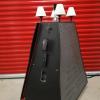An Open Letter to EV Charger Manufacturers
Doubling EV Infrastructure – with a software upgrade and extra plug
As electric vehicles (EVs) and plug-in hybrid vehicles are appealing to the mass market and becoming more pervasive, the EV charging infrastructure, after a brief surge in 2010-2013, has grown at a snail’s pace. Drivers are becoming frustrated with the lack of available chargers.
We have all passed by EV stations taken up by vehicles that have since been topped off, yet they remain, blocking others from using those electrons. On the other hand, when I park and plug in, I should not have to stop my work day, shopping or lunch and move the car the moment it is charged. EVs are about convenience; they should not be about playing musical chairs. EV manufactures and business owners have come up with a dismal non-solution of charging money to keep a car plugged in past the time it takes to charge. It may cost $0.25/kwh to charge, but the cost rises to $1.00/minute after the car is topped off. This forces the EV owner to watch his or her car’s status like a hawk. The stress is worse than that caused by range anxiety, and this silly game mitigates any fuel savings.
EV charging stations are used on a first-come, first-served basis, and that is how they should remain. To double the EV charging infrastructure, avoid being blocked by a fully charged EV or having to move a fully charged EV, a simple solution must exist.
Let’s examine the dual-plug EV charging station. This charging unit charges two vehicles with a dedicated plug until topped off, then goes unused. Why not add two or four additional corded plugs with the functionality that when the charger detects the first vehicle has been fully charged, it redirects the electricity to the next in line. In this fashion, the station succeeds in still charging two vehicles at a time. It just moves the power from one to the next based on the first-come, first-served principle.
Example: A dual-capacity EV charging station with four plugs and for parking spots.
First to arrive and plug into spot #1: Chevy Volt
Second to arrive and plug into spot #2: Nissan Leaf
Third to arrive and plug into spot #3: Tesla Model S
Fourth to arrive and plug into spot #4: BMW i3
Power flow begins immediately to the Volt and Leaf upon plugging in and activating the station, and similarly to the Leaf. The Model S is first in the queue, and the i3 is second. The Leaf exits after one hour and the electricity is immediately redirected automatically to start charging the Model S. At this point, the i3 moves to first in the queue. Meanwhile, a Ford Focus Electric arrives and parks in spot #2 and plugs in. The Focus is second in the queue. After another hour the Volt is fully charged and electricity is redirected automatically to the i3. The Focus in now first in the queue. This cycle is continued over and over. As vehicles are fully charged or unplugged while charging, the power flows to the next in line.
This upgrade requires a software update and added corded plugs. However, this simple modification could more than double the number of cars being charged at the station and furthermore, reduce the effects of leaving a fully charged car plugged in. This concept still relies on the first-come, first-served principle.
The only way to absolutely eliminate the problem would be to offer a dedicated plug for every parking spot, which is currently impractical. Until then, our proposed solution is an easy and cost effective way to keep the EV movement charging ahead.
Best regards,
Jacob Caya
Plug-In Owner















